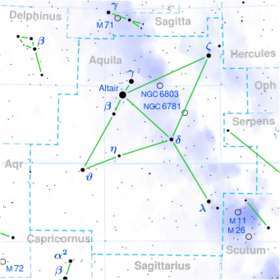Astronomy:10 Aquilae
| Observation data Epoch J2000.0 Equinox (celestial coordinates) | |
|---|---|
| Constellation | Aquila |
| Right ascension | 18h 58m 46.92419s[1] |
| Declination | +13° 54′ 23.9354″[1] |
| Apparent magnitude (V) | 5.893[2] |
| Characteristics | |
| Spectral type | F0 p Sr Eu[3] |
| U−B color index | +0.100[2] |
| B−V color index | +0.257[2] |
| Variable type | roAp[4] |
| Astrometry | |
| Radial velocity (Rv) | +14.5[5] km/s |
| Proper motion (μ) | RA: +1.01[1] mas/yr Dec.: -51.11[1] mas/yr |
| Parallax (π) | 13.45 ± 0.67[1] mas |
| Distance | 240 ± 10 ly (74 ± 4 pc) |
| Absolute magnitude (MV) | +2.69[6] |
| Details | |
| Mass | 1.39 ± 0.07[7] M☉ |
| Radius | 2.46 ± 0.06[7] R☉ |
| Luminosity | 17.73 ± 0.88[7] L☉ |
| Surface gravity (log g) | 3.8[7] cgs |
| Temperature | 7,550[7] K |
| Metallicity [Fe/H] | +0.55 ± 0.17[8] dex |
| Rotational velocity (v sin i) | +18[9] km/s |
| Other designations | |
| Database references | |
| SIMBAD | data |
10 Aquilae (abbreviated 10 Aql) is a star in the equatorial constellation of Aquila. 10 Aquilae is the Flamsteed designation. It has an apparent visual magnitude of 5.9[2] and thus is a faint star that is just visible to the naked eye in dark skies. The brightness of this star is diminished by 0.17 in visual magnitude from extinction caused by interstellar gas and dust.[8] Based on an annual parallax shift of 13.45 mas, the distance to this star is around 240 light-years (74 parsecs).
The outer envelope of this star has an effective temperature of 7,550 K, giving it the yellow-white hued glow of an F-type star.[10] It is a type of chemically peculiar star known as an Ap star, as indicated by the 'p' in the stellar classification.
10 Aql was described as a variable star in 1973 and a period of six days was suggested.[11] Its small amplitude, period, chemical peculiarity, and position in the H–R diagram indicated that it may be an α2 CVn variable and it was given this classification in the General Catalogue of Variable Stars, along with the variable star designation V1286 Aquilae.[12] Later studies showed that the period was spurious and several very short pulsation periods were found: 11.6, 12.0, and 13.4 minutes. This indicated that 10 Aql was a member of the new rapidly oscillating Ap star class.[13]
References
- ↑ 1.0 1.1 1.2 1.3 1.4 van Leeuwen, F. (November 2007), "Validation of the new Hipparcos reduction", Astronomy and Astrophysics 474 (2): 653–664, doi:10.1051/0004-6361:20078357, Bibcode: 2007A&A...474..653V.
- ↑ 2.0 2.1 2.2 2.3 Stepien, K. (December 1968), "Photometric behavior of magnetic stars", Astrophysical Journal 154: 945, doi:10.1086/149815, Bibcode: 1968ApJ...154..945S.
- ↑ Cowley, A. et al. (April 1969), "A study of the bright A stars. I. A catalogue of spectral classifications", Astronomical Journal 74: 375–406, doi:10.1086/110819, Bibcode: 1969AJ.....74..375C.
- ↑ Sachkov, M.; Kochukov, O.; Ryabchikova, T.; Leone, F.; Bagnulo, S.; Weiss, W. W. (2008). "Spectroscopic study of pulsations in the atmosphere of ro Ap star 10 Aql". Contributions of the Astronomical Observatory Skalnaté Pleso 38 (2): 323–328. Bibcode: 2008CoSka..38..323S.
- ↑ Wilson, Ralph Elmer (1953), "General catalogue of stellar radial velocities", Washington (Carnegie Institution of Washington), Bibcode: 1953GCRV..C......0W.
- ↑ Ryabchikova, T. A.; Savanov, I. S.; Hatzes, A. P.; Weiss, W. W.; Handler, G. (2000). "Abundance analyses of ro Ap stars. VI. 10 Aql and HD 122970". Astronomy and Astrophysics 357: 981. Bibcode: 2000A&A...357..981R.
- ↑ 7.0 7.1 7.2 7.3 7.4 Nesvacil, N.; Shulyak, D.; Ryabchikova, T. A.; Kochukhov, O.; Akberov, A.; Weiss, W. (2013). "A self-consistent chemically stratified atmosphere model for the ro Ap star 10 Aquilae". Astronomy & Astrophysics 552: A28. doi:10.1051/0004-6361/201220320. Bibcode: 2013A&A...552A..28N.
- ↑ 8.0 8.1 Koleva, M.; Vazdekis, A. (February 2012), "Stellar population models in the UV. I. Characterisation of the New Generation Stellar Library", Astronomy & Astrophysics 538: A143, doi:10.1051/0004-6361/201118065, Bibcode: 2012A&A...538A.143K.
- ↑ Royer, F. et al. (October 2002), "Rotational velocities of A-type stars in the northern hemisphere. II. Measurement of v sin i", Astronomy and Astrophysics 393 (3): 897–911, doi:10.1051/0004-6361:20020943, Bibcode: 2002A&A...393..897R.
- ↑ "The Colour of Stars", Australia Telescope, Outreach and Education (Commonwealth Scientific and Industrial Research Organisation), December 21, 2004, archived from the original on March 18, 2012, https://web.archive.org/web/20120318151427/http://outreach.atnf.csiro.au/education/senior/astrophysics/photometry_colour.html, retrieved 2012-01-16.
- ↑ Guerrero, G.; Mantegazza, L. (1973). "The photometric variability of Ap STAR 10 AQL". Memorie della Società Astronomia Italiana 44: 377. Bibcode: 1973MmSAI..44..377G.
- ↑ Samus, N. N. et al. (2009). "VizieR Online Data Catalog: General Catalogue of Variable Stars (Samus+ 2007-2013)". VizieR On-line Data Catalog: B/GCVS. Originally Published in: 2009yCat....102025S 1. Bibcode: 2009yCat....102025S.
- ↑ Heller, Clayton H.; Kramer, Karen S. (1990). "A frequency analysis of the new rapidly oscillating AP star 10 Aquilae". Monthly Notices of the Royal Astronomical Society 244: 372. Bibcode: 1990MNRAS.244..372H.
External links
 |


